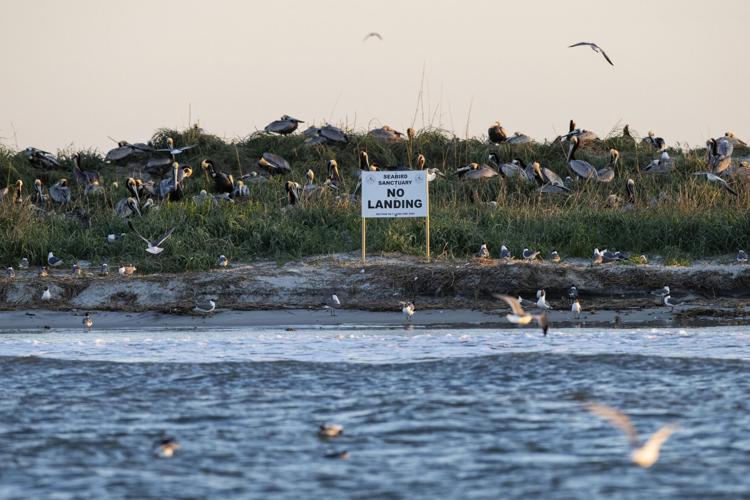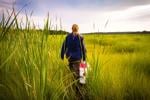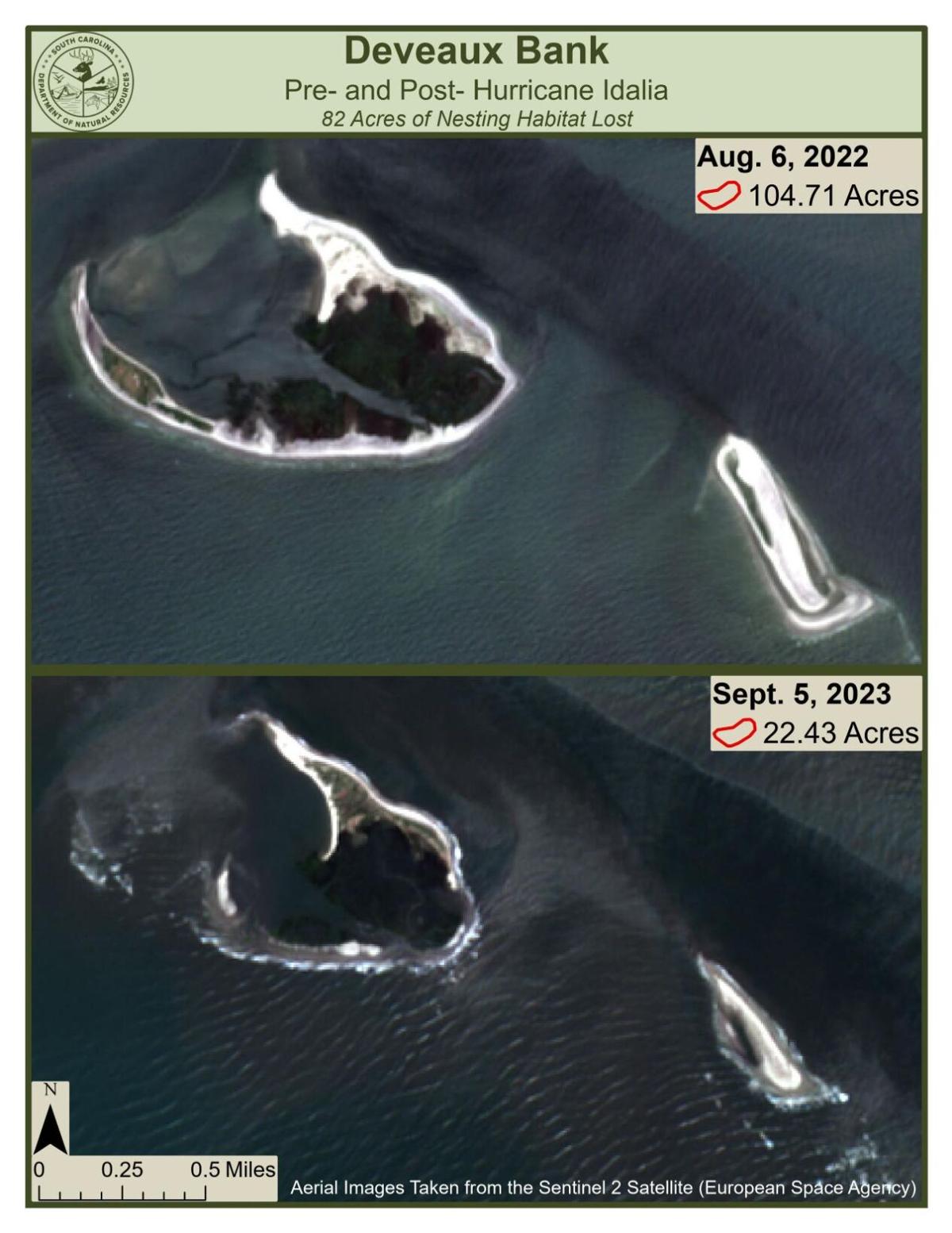Two boats full of birders floated slowly down the North Edisto River as the sun set and the moon popped up from a hat-shaped cloud. Ahead was Deveaux Bank, a rapidly vanishing island that’s among the most important bird sanctuaries on the East Coast.
The birders were there on this recent April evening to glimpse a migratory wonder, one that South Carolina scientists had only recently discovered: the return of the whimbrels.
Whimbrels are large shorebirds with speckled brown-and-white feathers. They have long curved bills, perfect for feeding on insects and Lowcountry fiddler crabs. They're long-distance fliers, sometimes migrating nonstop from the southern tip of South America to Deveaux Bank.
Here on this horseshoe-shaped patch of sand, whimbrels roost for a few weeks in mid-spring, resting for their next long flight to the Arctic. In 2009, scientists in Virginia captured a female whimbrel and attached a transmitter. They named the bird Hope and tracked her for three years. Hope flew more than 50,000 miles.
Like many shorebirds, whimbrels are in trouble. Various studies have found their numbers roughly cut in half since the 1990s. Which is why Deveaux Bank has become so precious.
It’s also why Chris Crolley, who runs Coastal Expeditions, wanted to take the birders to this beautiful and disappearing way station.

Chris Crolley, owner of Coastal Expeditions, addresses a crowd of bird enthusiasts on the dock at Cherry Point Landing before they head out to see whimbrels on Deveaux Bank on April 24, 2024, on Wadmalaw Island.
Whimbrel discovery
The boats left a landing on Wadmalaw Island as the early evening sun cast the marsh in amber. About 75 people were on board, many lugging binoculars and cameras with long lenses. The boats puttered past Rockville, a tiny town on Wadmalaw Island with residents who have long used Deveaux Bank as a place to picnic or fish. “See that,” Crolley suddenly said as the boat moved into the North Edisto River. “Flying across the sun — whimbrels!”
They flew in ragged formation, possibly from nearby marshlands where they had fed.
“They might fly nonstop from Argentina. And when they land here, they’re two things — tired and hungry,” Crolley told the group. “They’ll rest and feed here and become even more beautiful than they were when they arrived.”
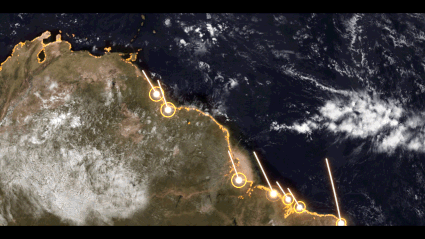
Courtesy of Cornell Lab of Ornithology
To the left, windows on Seabrook Island’s beachside homes reflected the setting sun. To the right, the silhouetted and preserved forests of Botany Bay grew darker. Ahead, at the North Edisto's mouth, was Deveaux Bank, the site of a surprising revelation.
For years, scientists weren’t sure where whimbrels stopped during their epic journeys north. Then, one morning in 2014, Felicia Sanders, a biologist with the state Department of Natural Resources, noticed whimbrels leaving Deveaux Bank. Did some whimbrels use Deveaux as their secret way station?
Over time, she and her colleagues gathered more data, and on a full moon night in 2019, they did a comprehensive tally: More than 20,000 whimbrels were on Deveaux, about half the known Atlantic population. They'd been hiding in plain sight. After the count, John Fitzpatrick of the Cornell Lab of Ornithology, told The New York Times it “was one of the most mind-blowing discoveries in the history of 20th- and 21st-century ornithology.”
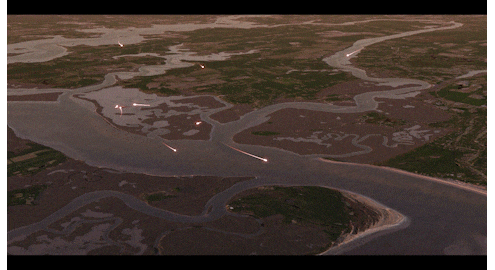
Courtesy of Cornell Lab of Ornithology
At that time, Deveaux Bank was more than 200 acres.
But as the boats closed in on this late April evening, it soon became clear that much of the whimbrels’ rest stop was under water. "What's left? Maybe 10 or 15 acres." Crolley guessed.
The reasons for Deveaux's disappearing act are many: the natural flux of sandbars at a river inlet; brutal storms, including Hurricane Idalia and last December’s nor’easter; rising tides from a rapidly warming planet.
Add these natural and climate change factors to increasing coastal development, and you have what Crolley called the "coastal squeeze.”
Which is why he and other conservationists are frustrated and angry that the state Department of Natural Resources has declined to close what’s left of Deveaux Bank.
Other coastal shorebird sanctuaries, including Charleston’s Crab Bank, are off limits during nesting season.
“Why isn’t Deveaux?” Crolley asked the group.

Laughing gulls and brown pelicans rest near a “NO LANDING” sign on Deveaux Bank on April 24, 2024. The signs were placed on the island by the South Carolina Department of Natural Resources to alert boaters of the seabird sanctuary status.
Other SC bird sanctuaries are closed
Part of the answer was back on shore in Rockville.
The town’s mayor, Riley Bradham, said Deveaux has long been a favored fishing and beachcombing spot. Access to Deveaux is part of Wadmalaw’s cultural heritage, he said, adding that he and residents also are acutely aware that people can harm birds merely by their presence. Getting too close can create “flares,” disturbances that cause birds to flee their nests. This opens them to predatory gulls or the sun’s heat, which can cook eggs or newly hatched chicks in minutes. “It’s a balancing act,” he said of DNR’s management.
Part of the answer is even farther inland, in DNR’s offices, where staff “try to do what’s best for the birds, while trying to balance that with public use and enjoyment of the area,” said Emily Cope, deputy director of wildlife and freshwater fisheries.
Still, when asked for specific metrics used to balance these interests, the agency had trouble coming up with them. How much high ground is left on Deveaux? The agency's latest calculation was made eight months ago after Hurricane Idalia spun past the coast and left behind just 22 acres of high ground.
At the same time, officials are clearer about the sanctuary’s importance, noting how last year Deveaux Bank hosted more than 3,000 pelican nests, roughly three-quarters of the state’s nesting pelican population and the largest colony on the Atlantic coast. They noted how in recent weeks they'd seen terns and black skimmers flying low over the island, scouting for stretches of sand to nest.
And, they said that so much of Deveaux is under water from mid tide to high tide that the agency can't post off-limits signs in some areas. Instead, the agency is depending on people to abide by what's in a new map.
The map shows what's open — the bank’s southern corner — and what's closed. Dogs aren’t allowed no matter where you go, and violators can be fined $465.

Part of Deveaux Bank will be closed during nesting season in 2024. This map shows where you can and cannot land a boat. No dogs are allowed at any time. DNR/Provided
To some conservationists, the agency’s actions seem like futile contortions.
Dana Beach, a longtime conservationist, said he remembered the island once had trees. Not anymore. “When Deveaux was larger, opening it had an impact on the shorebirds, but it wasn’t an existential impact. So DNR’s attitude now is bizarre and mostly inexplicable.”
Riley Egger of the Coastal Conservation League said that last week she saw more than 3,000 red knots in the area, and that later she saw four boats anchored in the same spot. "Shorebirds are declining faster than any other group of birds partly because humans increasingly use their habitats," she said. "Deveaux Bank is a site of international importance."
Back on the boat, Crolley rattled off the names of the state’s shorebird sanctuaries: Tomkins Island toward Savannah, Deveaux Bank, Bird Key Stono and Charleston Harbor’s Crab Bank.
“They’re all protected, except Deveaux.” He pointed toward Rockville. “Because someone over there thinks it's a good fishing spot.”

Whimbrels rest on a shell bank with other birds along Bohicket Creek on April 24, 2024.
Seeing the whimbrels
Conservationists say Deveaux Bank is so important the state should even consider renourishing it, as it did with Crab Bank — an idea that DNR also has resisted.
Local groups are seeking a grant to study sand transport around Deveaux. They asked for DNR's comments. In response, the agency said it doesn’t support renourishing. “Deveaux is naturally dynamic and erodes and rebuilds," the agency said in a document obtained by The Post and Courier. “… Artificially placed sand would not stay put for long thus renourishing is not worth the effort and funds.”
State Sen. Chip Campsen, R-Isle of Palms, said he’s long known about the importance of protecting Deveaux, and that a renourishment project shouldn’t be ruled out. He’d fought for more enforcement of existing closure rules in the past, especially during the pandemic, when more people seemed to treat the island as just another beach spot. “We had folks who weren’t respectful of the boundaries,” he said. Given its diminished size, “should it be totally closed now? I think we should take a hard look at that.”

Birders watch from the Edisto River on a Coastal Expeditions boat as the sun sets on Deveaux Bank and birds fill the sky on Tuesday, April 24, 2024.
On that recent evening trip to Deveaux, the sun set as Crolley slowed near the southwestern tip, the spot where people can legally land their boats and walk around.
The moon was higher now. In the twilight, the western sky glowed pinkish orange.
The birders hoisted their cameras and pointed them toward the sand and ridge of waist-high dunes. A breeze carried a symphony of squawks and whistles and chirps. The smell of bird dung grew stronger. Birds were everywhere, pelicans crammed into the dunes, black skimmers and whimbrels lifting off like confetti swept by gusts. “They look like bees!” Crolley said. Thousands and thousands of birds. All on this shrinking patch of sand.



